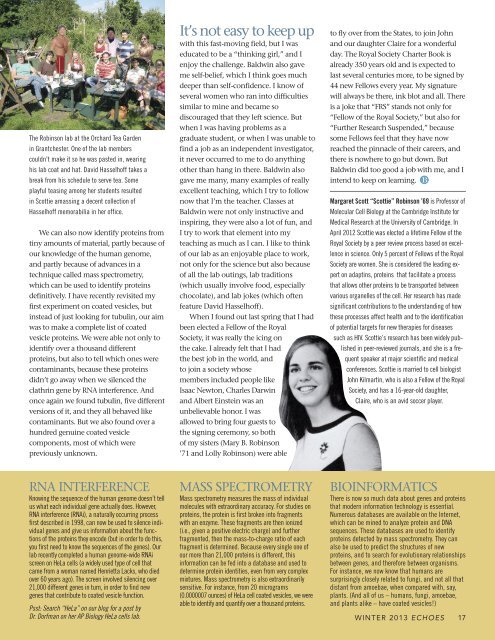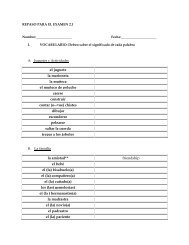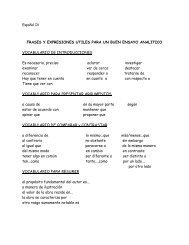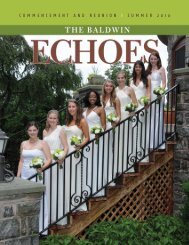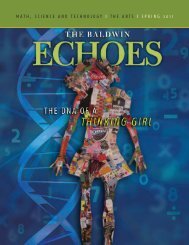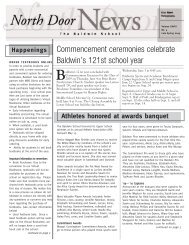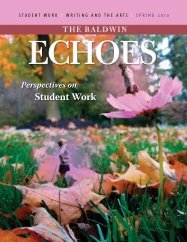Winter 2013 - Baldwin School
Winter 2013 - Baldwin School
Winter 2013 - Baldwin School
You also want an ePaper? Increase the reach of your titles
YUMPU automatically turns print PDFs into web optimized ePapers that Google loves.
The Robinson lab at the Orchard Tea Garden<br />
in Grantchester. One of the lab members<br />
couldn't make it so he was pasted in, wearing<br />
his lab coat and hat. David Hasselhoff takes a<br />
break from his schedule to serve tea. Some<br />
playful teasing among her students resulted<br />
in Scottie amassing a decent collection of<br />
Hasselhoff memorabilia in her office.<br />
We can also now identify proteins from<br />
tiny amounts of material, partly because of<br />
our knowledge of the human genome,<br />
and partly because of advances in a<br />
technique called mass spectrometry,<br />
which can be used to identify proteins<br />
definitively. I have recently revisited my<br />
first experiment on coated vesicles, but<br />
instead of just looking for tubulin, our aim<br />
was to make a complete list of coated<br />
vesicle proteins. We were able not only to<br />
identify over a thousand different<br />
proteins, but also to tell which ones were<br />
contaminants, because these proteins<br />
didn’t go away when we silenced the<br />
clathrin gene by RNA interference. And<br />
once again we found tubulin, five different<br />
versions of it, and they all behaved like<br />
contaminants. But we also found over a<br />
hundred genuine coated vesicle<br />
components, most of which were<br />
previously unknown.<br />
It’s not easy to keep up<br />
with this fast-moving field, but I was<br />
educated to be a “thinking girl,” and I<br />
enjoy the challenge. <strong>Baldwin</strong> also gave<br />
me self-belief, which I think goes much<br />
deeper than self-confidence. I know of<br />
several women who ran into difficulties<br />
similar to mine and became so<br />
discouraged that they left science. But<br />
when I was having problems as a<br />
graduate student, or when I was unable to<br />
find a job as an independent investigator,<br />
it never occurred to me to do anything<br />
other than hang in there. <strong>Baldwin</strong> also<br />
gave me many, many examples of really<br />
excellent teaching, which I try to follow<br />
now that I’m the teacher. Classes at<br />
<strong>Baldwin</strong> were not only instructive and<br />
inspiring, they were also a lot of fun, and<br />
I try to work that element into my<br />
teaching as much as I can. I like to think<br />
of our lab as an enjoyable place to work,<br />
not only for the science but also because<br />
of all the lab outings, lab traditions<br />
(which usually involve food, especially<br />
chocolate), and lab jokes (which often<br />
feature David Hasselhoff).<br />
When I found out last spring that I had<br />
been elected a Fellow of the Royal<br />
Society, it was really the icing on<br />
the cake. I already felt that I had<br />
the best job in the world, and<br />
to join a society whose<br />
members included people like<br />
Isaac Newton, Charles Darwin<br />
and Albert Einstein was an<br />
unbelievable honor. I was<br />
allowed to bring four guests to<br />
the signing ceremony, so both<br />
of my sisters (Mary B. Robinson<br />
’71 and Lolly Robinson) were able<br />
to fly over from the States, to join John<br />
and our daughter Claire for a wonderful<br />
day. The Royal Society Charter Book is<br />
already 350 years old and is expected to<br />
last several centuries more, to be signed by<br />
44 new Fellows every year. My signature<br />
will always be there, ink blot and all. There<br />
is a joke that “FRS” stands not only for<br />
“Fellow of the Royal Society,” but also for<br />
“Further Research Suspended,” because<br />
some Fellows feel that they have now<br />
reached the pinnacle of their careers, and<br />
there is nowhere to go but down. But<br />
<strong>Baldwin</strong> did too good a job with me, and I<br />
intend to keep on learning.<br />
Margaret Scott “Scottie” Robinson ’69 is Professor of<br />
Molecular Cell Biology at the Cambridge Institute for<br />
Medical Research at the University of Cambridge. In<br />
April 2012 Scottie was elected a lifetime Fellow of the<br />
Royal Society by a peer review process based on excellence<br />
in science. Only 5 percent of Fellows of the Royal<br />
Society are women. She is considered the leading expert<br />
on adaptins, proteins that facilitate a process<br />
that allows other proteins to be transported between<br />
various organelles of the cell. Her research has made<br />
significant contributions to the understanding of how<br />
these processes affect health and to the identification<br />
of potential targets for new therapies for diseases<br />
such as HIV. Scottie’s research has been widely published<br />
in peer-reviewed journals, and she is a frequent<br />
speaker at major scientific and medical<br />
conferences. Scottie is married to cell biologist<br />
John Kilmartin, who is also a Fellow of the Royal<br />
Society, and has a 16-year-old daughter,<br />
Claire, who is an avid soccer player.<br />
RNA INTERFERENCE<br />
Knowing the sequence of the human genome doesn’t tell<br />
us what each individual gene actually does. However,<br />
RNA interference (RNAi), a naturally occurring process<br />
first described in 1998, can now be used to silence individual<br />
genes and give us information about the functions<br />
of the proteins they encode (but in order to do this,<br />
you first need to know the sequences of the genes). Our<br />
lab recently completed a human genome-wide RNAi<br />
screen on HeLa cells (a widely used type of cell that<br />
came from a woman named Henrietta Lacks, who died<br />
over 60 years ago). The screen involved silencing over<br />
21,000 different genes in turn, in order to find new<br />
genes that contribute to coated vesicle function.<br />
Psst: Search “HeLa” on our blog for a post by<br />
Dr. Dorfman on her AP Biology HeLa cells lab.<br />
MASS SPECTROMETRY<br />
Mass spectrometry measures the mass of individual<br />
molecules with extraordinary accuracy. For studies on<br />
proteins, the protein is first broken into fragments<br />
with an enzyme. These fragments are then ionized<br />
(i.e., given a positive electric charge) and further<br />
fragmented, then the mass-to-charge ratio of each<br />
fragment is determined. Because every single one of<br />
our more than 21,000 proteins is different, this<br />
information can be fed into a database and used to<br />
determine protein identities, even from very complex<br />
mixtures. Mass spectrometry is also extraordinarily<br />
sensitive. For instance, from 20 micrograms<br />
(0.0000007 ounces) of HeLa cell coated vesicles, we were<br />
able to identify and quantify over a thousand proteins.<br />
BIOINFORMATICS<br />
There is now so much data about genes and proteins<br />
that modern information technology is essential.<br />
Numerous databases are available on the Internet,<br />
which can be mined to analyze protein and DNA<br />
sequences. These databases are used to identify<br />
proteins detected by mass spectrometry. They can<br />
also be used to predict the structures of new<br />
proteins, and to search for evolutionary relationships<br />
between genes, and therefore between organisms.<br />
For instance, we now know that humans are<br />
surprisingly closely related to fungi, and not all that<br />
distant from amoebae, when compared with, say,<br />
plants. (And all of us – humans, fungi, amoebae,<br />
and plants alike – have coated vesicles!)<br />
WINTER <strong>2013</strong> ECHOES<br />
17


